
The Roland JX-3P is a synthesizer produced by Roland Corporation of Japan from 1983–1985. The "3P" in its name refers to "Programmable Preset Polyphonic". It is notable as one of the company's first synthesizers to incorporate a MIDI interface.
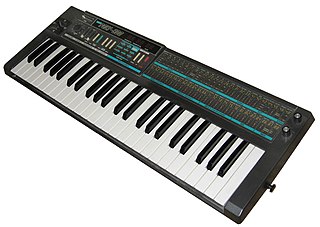
The Korg Poly-800 is an 8-voice analog synthesizer released by Korg in 1983. Its initial list price of $795 made it the first fully programmable polyphonic synthesizer that sold for less than $1,000. It was designed for portability, featuring battery power and a lightweight design that allowed the user to play with it strapped around their neck. It utilized digitally controlled oscillators (DCOs), and was a paraphonic synth with a single filter shared between its eight voices.

The Realistic Concertmate MG-1 is an analog synthesizer manufactured by Moog Music in 1981 and sold by Radio Shack from 1982 to 1983 under their "Realistic" brand name. It was produced without some standard Moog features, such as pitch and modulation wheels, as a cost-cutting measure aimed at achieving a lower price for the consumer market. The synthesizer also featured a pair of pass-through RCA jacks, which allowed users to mix radio or records into the final live synthesized sound output.

The Korg MS-20 is a patchable semi-modular monophonic analog synthesizer which Korg released in 1978 and which was in production until 1983. It was part of Korg's MS series of instruments, which also included the single oscillator MS-10, the keyboardless MS-50 module, the SQ-10 sequencer, and the VC-10 Vocoder. Additional devices included the MS-01 Foot Controller, MS-02 Interface, MS-03 Signal Processor, and MS-04 Modulation Pedal.
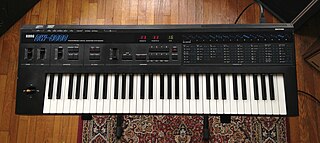
The Korg DW-8000 is a polyphonic hybrid digital-analog synthesizer released in 1985. It blends digital waveforms with an analog filter and amplifier, followed by a digital delay for adding echo effects. It boasts eight-note polyphony and its keyboard is equipped with velocity sensitivity and aftertouch.
The Korg Polysix(PS-6) is a six-voice polyphonic analog synthesizer released by Korg in 1981. It was one of the first affordable polyphonic synthesizers on the market, and was released as a cheaper alternative to the Sequential Prophet-5 and Oberheim OB-X, priced at approximately a third of the cost of its contemporaries in the polysynth market. It includes one VCO per voice, enhanced by a chorus/ensemble effect for added richness. It also comes equipped with 32 program memories and an integrated arpeggiator.

The Oberheim OB•12 is a Virtual Analog synthesizer, designed and realised by the Italian musical instrument manufacturer Viscount, in production between 2000 and 2005.
The Siel DK70 is a synthesizer produced in 1986 by Siel.

The Korg DSS-1 is a polyphonic sampling synthesizer released by Korg in 1986. As Korg's initial entry into the sampling market, the DSS-1 combines sampling, additive synthesis, and waveform drawing with an analog signal path. The DSS-1 was released a time when major synthesizer manufacturers like Yamaha and Casio were beginning to explore sampling, an area of sound design dominated by companies like Fairlight, E-mu, and Ensoniq. Korg did not stay long in the sampling arena; the DSS-1 was the company's only sampler until 1998 when Korg introduced sampling options on their Triton and Trinity series of workstations.
Casio's SDSynthesizers were a late-1980s line of analog synthesizers featuring a resonant filter. SD synthesis was traditional DCO-analog synthesis, with the main difference being that some of the SD waveforms' harmonic spectrums changed temporally, or dynamically in relation to the amplitude envelope.

The Prophet '08 is a polyphonic analog synthesizer released by Dave Smith Instruments (DSI) in 2007. As with DSI's other instruments, the Prophet '08 uses analog subtractive synthesis. Similar in functionality to the renowned Sequential Circuits Prophet-5 popularized in the 1970s, the Prophet '08 has an all analog signal path; however its envelopes are generated digitally.
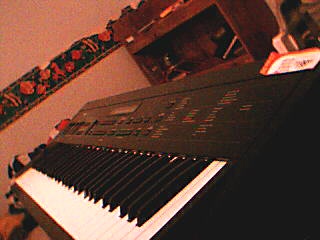
The Korg DS-8 is a digital eight-voice FM synthesizer released by Korg in 1987. Following an agreement with Yamaha for access to its research and development facilities, it was designed using Yamaha components and constructed under a licensing agreement. It introduced an analog-style interface for controlling FM sounds and could play different patches on each of its eight voices, marking it as Korg's first multi-timbral MIDI synthesizer. Accompanying its launch was the Korg 707, a more portable version of the DS-8, lacking digital effects but equipped with strap pegs for keytar performance.
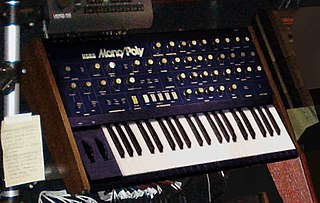
The Korg Mono/Poly (MP-4) is a paraphonic analog synthesizer released by Korg in 1981, bridging the gap between monophonic and polyphonic synthesis. Released in the same year as the Korg Polysix, as a complementary synth, The Mono/Poly is equipped with four VCOs and can operate as a four-voice paraphonic synth with limited capabilities, or as a monophonic synth using all four oscillators. Upon its release, it was the only monophonic synthesizer with an integrated quad-VCO design available on the market.

The Korg PS-3300 is a polyphonic analog synthesizer released by Korg in 1977. It was released alongside the PS-3100, a more compact variant featuring a complete synthesizer voice board for each of its 48 keyboard notes. The PS-3300 essentially combines three PS-3100 units, triggering all voices simultaneously with each key press and mirroring the PS-3100's overall design, featuring a total of 144 synth voices. The PS-3300 uses the PS-3010, a detachable keyboard equipped with an assignable joystick called the X-Y Manipulator.

The AX80 is a polyphonic analogue keyboard synthesizer manufactured by Akai Professional in 1984. It was Akai's first venture into the professional electronic musical instrument market. The AX80 used digitally controlled oscillators (DCO) and filter circuitry based on the Curtis Electronics CEM 3372 integrated circuit. It was marketed as part of a line of project studio equipment called the Akai Music Studio System, which included the S612 digital sampler the MR16 drum machine, the MS08 sequencer, and the MG1212 multitrack tape recorder, at a price of $1,695 US.

The Korg DW-6000 is a polyphonic hybrid digital-analog synthesizer released in 1985. It blends digital waveforms with an analog filter and amplifier, also incorporating a chorus effect to create an enriched analog sound. The DW-6000 features six-note polyphony and was quickly succeeded by the DW-8000, also released in 1985, which introduced a velocity sensitive keyboard with aftertouch, a built-in arpeggiator, increased polyphony and waveforms, and substituted the chorus effect with a digital delay effect.

The AX60 is a polyphonic analogue keyboard synthesizer manufactured by Akai Professional in the mid-1980s. It was Akai's answer to the popular Roland Juno series synthesizers. The AX60 uses voltage-controlled analogue oscillators and filter circuitry based on the Curtis Electronics CEM 3394 integrated circuit.

The CZ series is a family of low-cost phase distortion synthesizers produced by Casio in the mid-1980s. Eight models of CZ synthesizers were released: the CZ-101, CZ-230S, CZ-1000, CZ-2000S, CZ-2600S, CZ-3000, CZ-5000, and the CZ-1. Additionally, the home-keyboard model CT-6500 used 48 phase distortion presets from the CZ line. The CZ synthesizers' price at the time of their introduction made programmable synthesizers affordable enough to be purchased by garage bands. Yamaha soon introduced their own low-cost digital synthesizers, including the DX-21 (1985) and Yamaha DX100, in light of the CZ series' success.

The Korg Minilogue is a polyphonic analog synthesizer released in 2016 by Korg. It offers users four-voice polyphony with two analog VCOs per-voice and was designed to be affordable. It was designed by Korg engineer and synthesizer designer Tatsuya Takahashi, who said "the concept of the Minilogue was to build an analog synthesizer that doesn't rely on the fame and success of an old synth".
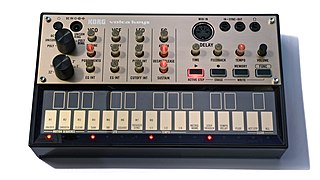
The Volca Keys is a analogue synthesizer manufactured by the Japanese music technology company Korg. It was announced in April 2013 at MusikMesse and was at the time one of the few affordable analogue synthesizers available. The Volca Keys uses subtractive synthesis to create sounds and is three-note paraphonic, meaning that it can play chords with all voices sharing a single voltage-controlled filter (VCF).


















